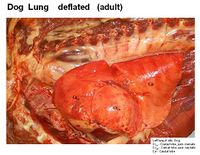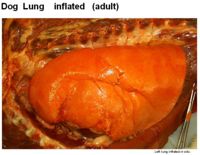Difference between revisions of "Lungs - Anatomy & Physiology"
Jump to navigation
Jump to search
Fiorecastro (talk | contribs) |
|||
| (61 intermediate revisions by 12 users not shown) | |||
| Line 1: | Line 1: | ||
| − | {{ | + | {{toplink |
| + | |backcolour = FAFAD2 | ||
| + | |linkpage =Cardiorespiratory System - Anatomy & Physiology | ||
| + | |linktext =Cardiorespiratory System | ||
| + | |maplink = Cardiorespiratory (Content Map) - Anatomy & Physiology | ||
| + | |pagetype =Anatomy | ||
| + | }} | ||
| + | <br> | ||
| + | |||
| + | [[Image:Doglungdeflated.jpg|right|thumb|200px|©RVC 2008]] | ||
| + | |||
==Introduction== | ==Introduction== | ||
| − | |||
| − | |||
| − | The lungs are the site for | + | [[Image:Doglunginflated.jpg|right|thumb|200px|©RVC 2008]] |
| + | The lungs are the site for gaseous exchange, and are situated within the thoracic cavity. They occupy approximatley 5% of the body volume in mammals when relaxed, but generally have no fixed size or shape since their volume is constantly changing with the processes of inspiration and expiration. | ||
| − | The lungs, along with the | + | The lungs, along with the larynx and trachea, develop from a ventral respiratory tract. After separation from the developing oesophagus, two lung buds develop, which undergo divisions as they grow, forming the beginnings of the bronchial tree. This process is not completed by birth. |
==Structure== | ==Structure== | ||
| − | |||
| − | In most species | + | *The left and right lungs lie within their pleural sac and are only attached by their roots, to the [[Mediastinum - Anatomy & Physiology|mediastinum]], so they are fairly free within the thoracic cavity. |
| + | *The right lung is always larger than the left, due to the positioning of the heart. The apex of the lungs is the cranial point. | ||
| + | *In most species the lungs are divided into lobes by the bronchial tree: | ||
| + | **Left Lung = Cranial and Caudal lobes. | ||
| + | **Right Lung = Cranial, Caudal, Middle and Accessory lobes. The cranial lobe is further divided by an external fissure.[[Image:Routeofairthroughrespiratorysystem.jpg|right|thumb|200px|'''Schematic Diagram showing the route air takes through the respiratory system''']] | ||
| + | *The bulk of the lung consists of bronchi, blood vessels and connective tissue. The terminal bronchioles have alveoli scattered along their length, and are continued by alveolar ducts, alveolar sacs and finally alveoli. | ||
| + | **Alveolar Ducts: These have alveoli which open on all of it's sides, they have no 'walls' as such. Openings to individual alveoli are guarded by smooth muscle. | ||
| + | **Alveolar Sacs: These are rotunda-like areas on the end of the alveolar ducts, usually there are clusters of these at the end of each duct. | ||
| + | **Alveoli: These are minute, polygonal chambers, whose diameter changes with the processes of inspiration and expiration, and varies by species. The wall of the alveoli is extremely thin, consisting of 2 irregular layers of epithelial sheets, 'sandwiching' a network of capillaries. Thus the ''Blood-Gas Barrier'' is just a single basal lamina - ideal for gaseous exchange. | ||
| + | The alveolar interstitium is formed from connective tissue fibres and cells, which include collagen fibrils and elastin fibres. | ||
| − | + | ==Function== | |
| − | |||
| − | |||
| − | |||
| − | |||
| − | |||
| − | === | ||
| − | |||
| − | + | *Gaseous Exchange | |
| − | |||
| − | |||
| − | |||
| − | |||
| − | |||
| − | |||
==Vasculature== | ==Vasculature== | ||
| − | The ''' | + | *The '''Pulmonary Arteries''' follow the bronchi while the '''Pulmonary veins''' sometimes run separately. |
| + | *'''Bronchial arteries''' from the Aorta supply the bronchi, and '''Bronchial veins''' may drain this blood to the right atrium via the '''Azygous Vein'''. More often the blood from the bronchi drains directly to the left atrium. | ||
==Innervation== | ==Innervation== | ||
| − | Nervous supply to the lung is via the ''' | + | * Nervous supply to the lung is via the '''Pulmonary Plexus''' within the mediastinum. |
| − | |||
==Lymphatics== | ==Lymphatics== | ||
| − | Lymph drains to the ''' | + | * Lymph drains to the '''Tracheobronchial''' and '''Mediastinal''' lymph nodes. |
==Histology== | ==Histology== | ||
| − | |||
| − | |||
| − | |||
| − | |||
| − | |||
<center><gallery> | <center><gallery> | ||
| Line 64: | Line 63: | ||
==Species Differences== | ==Species Differences== | ||
| − | + | * Externally the lungs of the '''Horse''' show almost no lobation. Internally the right lung of the horse lacks a Middle Lobe. | |
| + | *The lungs of '''Ruminants''' and '''Pigs''' are obviously lobed. | ||
| + | *The fissures between lobes (''Interlobar fissures'') are deeper in the dog and cat lung compared to other species. | ||
==Links== | ==Links== | ||
| − | |||
| − | |||
| − | |||
| − | |||
| − | |||
| − | |||
| − | |||
| − | |||
| − | |||
| − | |||
==References== | ==References== | ||
| − | {{citation|initiallast = Dyce|initialfirst = K.M|2last = Sack|2first = W.O|finallast = Wensing|finalfirst = C.J.G|year = 2002|title = Textbook of Veterinary Anatomy|ed =3rd|city = Philadelphia|pub = Saunders}} | + | *{{citation|initiallast = Dyce|initialfirst = K.M|2last = Sack|2first = W.O|finallast = Wensing|finalfirst = C.J.G|year = 2002|title = Textbook of Veterinary Anatomy|ed =3rd|city = Philadelphia|pub = Saunders}} |
| − | |||
| − | |||
| − | |||
| − | |||
| − | |||
Revision as of 07:49, 13 August 2008
|
|
Introduction
The lungs are the site for gaseous exchange, and are situated within the thoracic cavity. They occupy approximatley 5% of the body volume in mammals when relaxed, but generally have no fixed size or shape since their volume is constantly changing with the processes of inspiration and expiration.
The lungs, along with the larynx and trachea, develop from a ventral respiratory tract. After separation from the developing oesophagus, two lung buds develop, which undergo divisions as they grow, forming the beginnings of the bronchial tree. This process is not completed by birth.
Structure
- The left and right lungs lie within their pleural sac and are only attached by their roots, to the mediastinum, so they are fairly free within the thoracic cavity.
- The right lung is always larger than the left, due to the positioning of the heart. The apex of the lungs is the cranial point.
- In most species the lungs are divided into lobes by the bronchial tree:
- Left Lung = Cranial and Caudal lobes.
- Right Lung = Cranial, Caudal, Middle and Accessory lobes. The cranial lobe is further divided by an external fissure.File:Routeofairthroughrespiratorysystem.jpgSchematic Diagram showing the route air takes through the respiratory system
- The bulk of the lung consists of bronchi, blood vessels and connective tissue. The terminal bronchioles have alveoli scattered along their length, and are continued by alveolar ducts, alveolar sacs and finally alveoli.
- Alveolar Ducts: These have alveoli which open on all of it's sides, they have no 'walls' as such. Openings to individual alveoli are guarded by smooth muscle.
- Alveolar Sacs: These are rotunda-like areas on the end of the alveolar ducts, usually there are clusters of these at the end of each duct.
- Alveoli: These are minute, polygonal chambers, whose diameter changes with the processes of inspiration and expiration, and varies by species. The wall of the alveoli is extremely thin, consisting of 2 irregular layers of epithelial sheets, 'sandwiching' a network of capillaries. Thus the Blood-Gas Barrier is just a single basal lamina - ideal for gaseous exchange.
The alveolar interstitium is formed from connective tissue fibres and cells, which include collagen fibrils and elastin fibres.
Function
- Gaseous Exchange
Vasculature
- The Pulmonary Arteries follow the bronchi while the Pulmonary veins sometimes run separately.
- Bronchial arteries from the Aorta supply the bronchi, and Bronchial veins may drain this blood to the right atrium via the Azygous Vein. More often the blood from the bronchi drains directly to the left atrium.
Innervation
- Nervous supply to the lung is via the Pulmonary Plexus within the mediastinum.
Lymphatics
- Lymph drains to the Tracheobronchial and Mediastinal lymph nodes.
Histology
Species Differences
- Externally the lungs of the Horse show almost no lobation. Internally the right lung of the horse lacks a Middle Lobe.
- The lungs of Ruminants and Pigs are obviously lobed.
- The fissures between lobes (Interlobar fissures) are deeper in the dog and cat lung compared to other species.
Links
References
- Dyce, K.M., Sack, W.O. and Wensing, C.J.G. (2002) Textbook of Veterinary Anatomy. 3rd ed. Philadelphia: Saunders.







